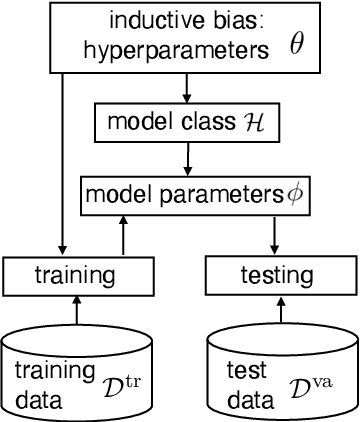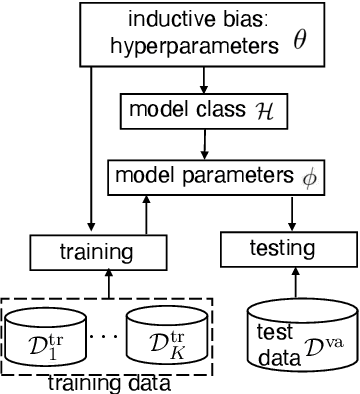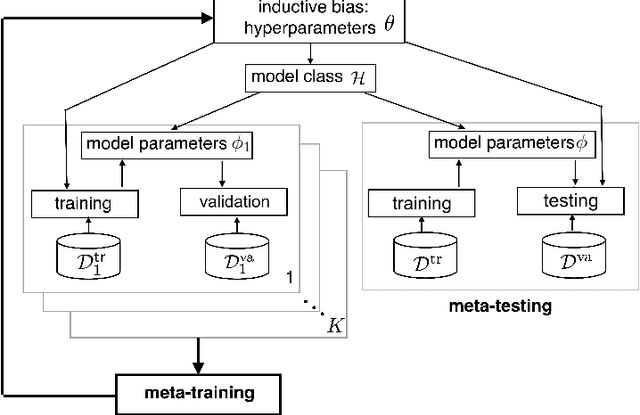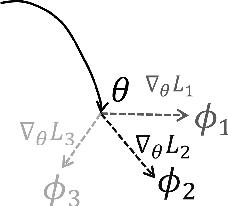Sharu Theresa Jose
VAE-QWGAN: Improving Quantum GANs for High Resolution Image Generation
Sep 16, 2024Abstract:This paper presents a novel hybrid quantum generative model, the VAE-QWGAN, which combines the strengths of a classical Variational AutoEncoder (VAE) with a hybrid Quantum Wasserstein Generative Adversarial Network (QWGAN). The VAE-QWGAN integrates the VAE decoder and QGAN generator into a single quantum model with shared parameters, utilizing the VAE's encoder for latent vector sampling during training. To generate new data from the trained model at inference, input latent vectors are sampled from a Gaussian Mixture Model (GMM), learnt on the training latent vectors. This, in turn, enhances the diversity and quality of generated images. We evaluate the model's performance on MNIST/Fashion-MNIST datasets, and demonstrate improved quality and diversity of generated images compared to existing approaches.
Adversarial Quantum Machine Learning: An Information-Theoretic Generalization Analysis
Jan 31, 2024Abstract:In a manner analogous to their classical counterparts, quantum classifiers are vulnerable to adversarial attacks that perturb their inputs. A promising countermeasure is to train the quantum classifier by adopting an attack-aware, or adversarial, loss function. This paper studies the generalization properties of quantum classifiers that are adversarially trained against bounded-norm white-box attacks. Specifically, a quantum adversary maximizes the classifier's loss by transforming an input state $\rho(x)$ into a state $\lambda$ that is $\epsilon$-close to the original state $\rho(x)$ in $p$-Schatten distance. Under suitable assumptions on the quantum embedding $\rho(x)$, we derive novel information-theoretic upper bounds on the generalization error of adversarially trained quantum classifiers for $p = 1$ and $p = \infty$. The derived upper bounds consist of two terms: the first is an exponential function of the 2-R\'enyi mutual information between classical data and quantum embedding, while the second term scales linearly with the adversarial perturbation size $\epsilon$. Both terms are shown to decrease as $1/\sqrt{T}$ over the training set size $T$ . An extension is also considered in which the adversary assumed during training has different parameters $p$ and $\epsilon$ as compared to the adversary affecting the test inputs. Finally, we validate our theoretical findings with numerical experiments for a synthetic setting.
Thompson Sampling for Stochastic Bandits with Noisy Contexts: An Information-Theoretic Regret Analysis
Jan 21, 2024Abstract:We explore a stochastic contextual linear bandit problem where the agent observes a noisy, corrupted version of the true context through a noise channel with an unknown noise parameter. Our objective is to design an action policy that can approximate" that of an oracle, which has access to the reward model, the channel parameter, and the predictive distribution of the true context from the observed noisy context. In a Bayesian framework, we introduce a Thompson sampling algorithm for Gaussian bandits with Gaussian context noise. Adopting an information-theoretic analysis, we demonstrate the Bayesian regret of our algorithm concerning the oracle's action policy. We also extend this problem to a scenario where the agent observes the true context with some delay after receiving the reward and show that delayed true contexts lead to lower Bayesian regret. Finally, we empirically demonstrate the performance of the proposed algorithms against baselines.
Statistical Complexity of Quantum Learning
Sep 20, 2023Abstract:Recent years have seen significant activity on the problem of using data for the purpose of learning properties of quantum systems or of processing classical or quantum data via quantum computing. As in classical learning, quantum learning problems involve settings in which the mechanism generating the data is unknown, and the main goal of a learning algorithm is to ensure satisfactory accuracy levels when only given access to data and, possibly, side information such as expert knowledge. This article reviews the complexity of quantum learning using information-theoretic techniques by focusing on data complexity, copy complexity, and model complexity. Copy complexity arises from the destructive nature of quantum measurements, which irreversibly alter the state to be processed, limiting the information that can be extracted about quantum data. For example, in a quantum system, unlike in classical machine learning, it is generally not possible to evaluate the training loss simultaneously on multiple hypotheses using the same quantum data. To make the paper self-contained and approachable by different research communities, we provide extensive background material on classical results from statistical learning theory, as well as on the distinguishability of quantum states. Throughout, we highlight the differences between quantum and classical learning by addressing both supervised and unsupervised learning, and we provide extensive pointers to the literature.
Bayesian and Multi-Armed Contextual Meta-Optimization for Efficient Wireless Radio Resource Management
Jan 16, 2023



Abstract:Optimal resource allocation in modern communication networks calls for the optimization of objective functions that are only accessible via costly separate evaluations for each candidate solution. The conventional approach carries out the optimization of resource-allocation parameters for each system configuration, characterized, e.g., by topology and traffic statistics, using global search methods such as Bayesian optimization (BO). These methods tend to require a large number of iterations, and hence a large number of key performance indicator (KPI) evaluations. In this paper, we propose the use of meta-learning to transfer knowledge from data collected from related, but distinct, configurations in order to speed up optimization on new network configurations. Specifically, we combine meta-learning with BO, as well as with multi-armed bandit (MAB) optimization, with the latter having the potential advantage of operating directly on a discrete search space. Furthermore, we introduce novel contextual meta-BO and meta-MAB algorithms, in which transfer of knowledge across configurations occurs at the level of a mapping from graph-based contextual information to resource-allocation parameters. Experiments for the problem of open loop power control (OLPC) parameter optimization for the uplink of multi-cell multi-antenna systems provide insights into the potential benefits of meta-learning and contextual optimization.
Learning with Limited Samples -- Meta-Learning and Applications to Communication Systems
Oct 03, 2022



Abstract:Deep learning has achieved remarkable success in many machine learning tasks such as image classification, speech recognition, and game playing. However, these breakthroughs are often difficult to translate into real-world engineering systems because deep learning models require a massive number of training samples, which are costly to obtain in practice. To address labeled data scarcity, few-shot meta-learning optimizes learning algorithms that can efficiently adapt to new tasks quickly. While meta-learning is gaining significant interest in the machine learning literature, its working principles and theoretic fundamentals are not as well understood in the engineering community. This review monograph provides an introduction to meta-learning by covering principles, algorithms, theory, and engineering applications. After introducing meta-learning in comparison with conventional and joint learning, we describe the main meta-learning algorithms, as well as a general bilevel optimization framework for the definition of meta-learning techniques. Then, we summarize known results on the generalization capabilities of meta-learning from a statistical learning viewpoint. Applications to communication systems, including decoding and power allocation, are discussed next, followed by an introduction to aspects related to the integration of meta-learning with emerging computing technologies, namely neuromorphic and quantum computing. The monograph is concluded with an overview of open research challenges.
Error Mitigation-Aided Optimization of Parameterized Quantum Circuits: Convergence Analysis
Sep 23, 2022



Abstract:Variational quantum algorithms (VQAs) offer the most promising path to obtaining quantum advantages via noisy intermediate-scale quantum (NISQ) processors. Such systems leverage classical optimization to tune the parameters of a parameterized quantum circuit (PQC). The goal is minimizing a cost function that depends on measurement outputs obtained from the PQC. Optimization is typically implemented via stochastic gradient descent (SGD). On NISQ computers, gate noise due to imperfections and decoherence affects the stochastic gradient estimates by introducing a bias. Quantum error mitigation (QEM) techniques can reduce the estimation bias without requiring any increase in the number of qubits, but they in turn cause an increase in the variance of the gradient estimates. This work studies the impact of quantum gate noise on the convergence of SGD for the variational eigensolver (VQE), a fundamental instance of VQAs. The main goal is ascertaining conditions under which QEM can enhance the performance of SGD for VQEs. It is shown that quantum gate noise induces a non-zero error-floor on the convergence error of SGD (evaluated with respect to a reference noiseless PQC), which depends on the number of noisy gates, the strength of the noise, as well as the eigenspectrum of the observable being measured and minimized. In contrast, with QEM, any arbitrarily small error can be obtained. Furthermore, for error levels attainable with or without QEM, QEM can reduce the number of required iterations, but only as long as the quantum noise level is sufficiently small, and a sufficiently large number of measurements is allowed at each SGD iteration. Numerical examples for a max-cut problem corroborate the main theoretical findings.
Transfer Learning in Quantum Parametric Classifiers: An Information-Theoretic Generalization Analysis
Jan 17, 2022



Abstract:A key step in quantum machine learning with classical inputs is the design of an embedding circuit mapping inputs to a quantum state. This paper studies a transfer learning setting in which classical-to-quantum embedding is carried out by an arbitrary parametric quantum circuit that is pre-trained based on data from a source task. At run time, the binary classifier is then optimized based on data from the target task of interest. Using an information-theoretic approach, we demonstrate that the average excess risk, or optimality gap, can be bounded in terms of two R\'enyi mutual information terms between classical input and quantum embedding under source and target tasks, as well as in terms of a measure of similarity between the source and target tasks related to the trace distance. The main theoretical results are validated on a simple binary classification example.
An Information-Theoretic Analysis of The Cost of Decentralization for Learning and Inference Under Privacy Constraints
Oct 11, 2021



Abstract:In vertical federated learning (FL), the features of a data sample are distributed across multiple agents. As such, inter-agent collaboration can be beneficial not only during the learning phase, as is the case for standard horizontal FL, but also during the inference phase. A fundamental theoretical question in this setting is how to quantify the cost, or performance loss, of decentralization for learning and/or inference. In this paper, we consider general supervised learning problems with any number of agents, and provide a novel information-theoretic quantification of the cost of decentralization in the presence of privacy constraints on inter-agent communication within a Bayesian framework. The cost of decentralization for learning and/or inference is shown to be quantified in terms of conditional mutual information terms involving features and label variables.
Transfer Bayesian Meta-learning via Weighted Free Energy Minimization
Jun 22, 2021



Abstract:Meta-learning optimizes the hyperparameters of a training procedure, such as its initialization, kernel, or learning rate, based on data sampled from a number of auxiliary tasks. A key underlying assumption is that the auxiliary tasks, known as meta-training tasks, share the same generating distribution as the tasks to be encountered at deployment time, known as meta-test tasks. This may, however, not be the case when the test environment differ from the meta-training conditions. To address shifts in task generating distribution between meta-training and meta-testing phases, this paper introduces weighted free energy minimization (WFEM) for transfer meta-learning. We instantiate the proposed approach for non-parametric Bayesian regression and classification via Gaussian Processes (GPs). The method is validated on a toy sinusoidal regression problem, as well as on classification using miniImagenet and CUB data sets, through comparison with standard meta-learning of GP priors as implemented by PACOH.
 Add to Chrome
Add to Chrome Add to Firefox
Add to Firefox Add to Edge
Add to Edge